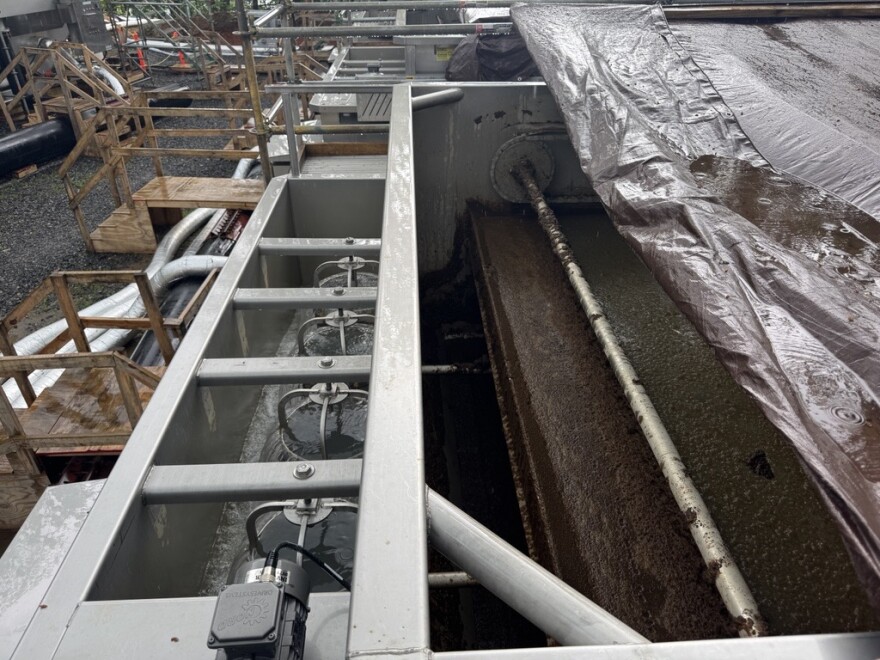Asheville’s temporary water pre-treatment system, set up by FEMA after Hurricane Helene, will be decommissioned at the end of the year, and officials say they’re working on a new, permanent solution.
FEMA will continue to fund the once-critical piece of water infrastructure in Asheville through the end of November, the City of Asheville announced on Tuesday.
In the meantime, public drinking water and municipal water services will function normally, city leaders told BPR in interviews.
Previously, FEMA had committed to funding the system only through September.
With funding expiring, the city will decommission the temporary water pre-treatment systems, which were installed at the North Fork and William DeBruhl water treatment plants.
Asheville Mayor Esther Manheimer said local officials advocated to keep the temporary systems in place through the end of the 2025 hurricane season. “That was the critical time period that we were fighting for,” she said.
The pre-treatment systems were crucial in the aftermath of Hurricane Helene, when floodwaters knocked out the city’s water system for 53 days, mucking up the watershed with cloudy sediment and debris. Turbidity levels peaked at around 80 Nephelometric Turbidity Units, which gave municipal water the consistency and color of chocolate milk.
“[The pre-treatment systems] take that turbid water that our filters can't handle. They run it through a dissolved air flotation process that, long story short, gets it to a turbidity level that our filters can handle,” Clay Chandler, the spokesperson for the water department, explained. “And right after the storm, that was critical because we couldn't treat any water.”

Now that turbidity levels are back to pre-storm levels, the systems aren’t crucial for daily operations, he said.
The water is drinkable without pre-treatment, but the city has maintained the systems as a contingency in case turbidity levels spike. They cost $6 million per month to maintain and FEMA has covered the entire cost up to this point.
“These pretreatment systems have provided a layer of redundancy in the event that we have a severe weather event that causes turbidity in the reservoirs,” Chandler said.
That could include another tropical storm, severe thunderstorm, or other heavy rainfall event that brings multiple inches of rain in the span of hours. The watershed is more vulnerable to a spike in turbidity now because of the increased sediment and vegetative debris brought on by Helene, he said.
In a “perfect world,” the city would keep the pre-treatment centers operational until it installs a permanent pre-treatment system, Chandler said. But without continued support from FEMA, the $6 million monthly cost is “completely out of reach” financially.
In September, Chandler said the watershed was still “very, very vulnerable.” But in an interview this week, he told BPR that “time heals.”
“Our watershed still is vulnerable, but it's not as vulnerable as it was, you know, six, eight months ago. So, we think we're in a pretty good spot,” he said.
A debris removal project, which began this week at North Fork Reservoir, will help the watershed become more resilient, he added.
The city has already begun the process of building a permanent pre-treatment solution for the North Fork and DeBruhl plants, but it could take up to five years and will cost around $100 million. So far, the city has invested $10 million in the design of these systems.
Asheville is the only water system in North Carolina that relies on direct filtration, Chandler said, “which means our filters can't treat especially turbid water.” He added that he thinks Asheville may also be “the only one left in the United States that uses that kind of system.”
The city is also hoping to create an alternate bypass out of the North Fork Reservoir that’s not in a floodplain. The existing bypass, which was repaired over the span of two weeks after Helene, sits near the Swannanoa River, an area where infrastructure is at higher risk for future flood events. The plan for an alternative bypass is currently in the design phase.



